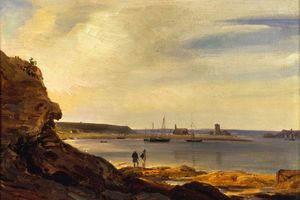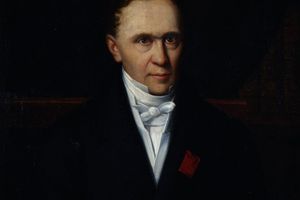Collections
The first director of the museum, the librarian Derennes, was succeeded in 1880 by Alfred Beau (1829-1907). Photographer and painter, he was artistic director of the Porquier pottery. He had increased the pottery’s success by designing decorative scenes representing daily life in Brittany. Over a period of twenty-four years, from 1880 to the date he left Quimper in 1904, Alfred Beau improved the collection with the addition of several dozen paintings. Each spring, he chose works for the annual Show with a Breton, or if possible, a Cornouaille theme. Along with the Member of Parliament Louis Hémon, he pressed for government grants or donations. La Fuite de Gradlon (The flight of Gradlon), La Veuve de l’île de Sein (The widow from the Ile de Sein) and Les Révoltés de Fouesnant (The rebels of Fouesnant) were enthusiastically received locally. The central administration had already sent Breton themed works to other parts of France, and efforts were multiplied to get these returned to Brittany. Works destined for other museums were successfully returned to Quimper. Alfred Beau and Louis Hémon were friends of academic painters installed in Concarneau, for example Théophile Deyrolle and Alfred Guillou, and from 1887 began to buy regularly from artists living or working in lower Brittany. They chose works by Pelouse, Trayer, Bernier, and Duveau, knowing nothing of the work of painters working alongside Gauguin in Pont-Aven and Le Pouldu.
In 1883, a commission was received from the State to decorate the hall with four paintings showing scenes from Quimper to Pont-Aven at four different times of the year. This work was entrusted to Le Camus and Joubert, with Deyrolle painting two canvases. This active policy would slow down at the beginning of the century.
Alfred Beau was not to be replaced by Fernand Guey until 1909. The museum was soon confronted with a problem of space, as no allowance had been made for storerooms in the museographic and architectural programmes. The municipal architect, who became designer of the museum project on the death of Silguy, had simply added together the surface of works. In theory, by superimposing the pictures on several levels, sometimes 7 to 8 metres high, there was space for the whole of Jean-Marie de Silguy’s collection on the walls. When large Breton-themed works arrived in Quimper, their display took precedence over the old collections, and these ended up being dispersed throughout the public buildings in Quimper. When the town benefited in 1894 from an important legacy of 74 paintings by Jean-Baptiste-Lucien Colomb, little enthusiasm was shown and the works were never displayed. The town sold several canvases from Silguy’s collection, considered as « minor » works, but that did not solve the problem of space.
In 1896, the Museum of Archaeology relinquished a room on the ground floor, in order to install a glass gallery in the yard to display a Noce bretonne (Breton wedding), and the space freed up made it possible to present the collection of sculptures. The surface area of the art galleries was not properly extended until1909, when the town built a new building on the site of the town hall garden, with the museum occupying the first floor, and again in 1911, when departmental collections were returned to the diocese.
Following the departure of Fernand Guey en 1917, the painter Charles Godeby was chosen as curator in 1922. There was little increase in collections before his departure in 1949.Gilberte Martin-Méry provided a valuable stimulus to the museum between 1949-1950 by building up the first collections in respect of the School of Pont-Aven and Max Jacob. With effect from 1955, the new curator, Pierre Quiniou, confirmed that these new directions would be implemented through purchases, donations and allocations, in particular on the occasion of important building work between 1972 and 1976.
> Load english label plates produced by students of Le Likes High School in Quimper for the City of Quimper Fine Arts Museum (PDF- 2.6 Mo- EN)


